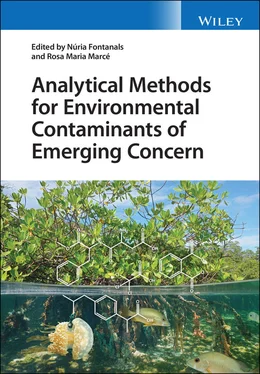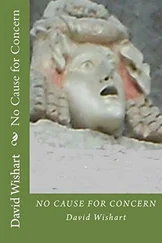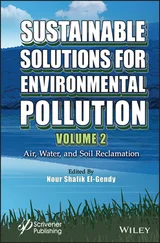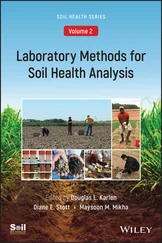1 ...7 8 9 11 12 13 ...27 Finally, pesticides are usually extracted from air using active or passive samplers (see Table 1.4). The active ones are mainly based on SPE by pumping high volumes of air through different sorbents such as Tenax TA, Carbotrap or polyurethane foam filter (PUF) [54, 102]. Passive samplers are based on diffusion through a well-defined barrier or membrane (e.g. Radiello) PUF disks or semipermeable membrane devices [33]. Then compounds are desorbed from the passive sampler using Soxhlet extraction [55, 103], microwave-assisted extraction [104], PLE [105] or ultrasound-assisted extraction [33]. In this sense, different solvents can be used for the extraction of pesticides from filters or membranes, such as ethyl acetate [57], acetone or petroleum ether [55]. Additionally, miniaturized methods can also be applied, and, for instance, pesticides were extracted from PM2.5 using a miniaturized device with 500 µL of 18% acetonitrile in dichloromethane followed by sonication and injection into GC-MS [58].
Table 1.3 Overview of analytical methods applied to determine pesticides in biota. a
| Pesticides |
Matrix |
Extraction technique |
Determination technique |
Recovery (%) |
LOQ (ng g−1) |
Reference |
| 50 |
Fish |
QuEChERS |
LC-QqQ |
— |
— |
[49] |
| 50 (TPs) |
Fish |
QuEChERS Clean-up: d-SPE (MgSO 4+ C 18+ active coal) |
LC-QqQ |
58−140 |
0.90−11.25 |
[46] |
| 40 (TPs) |
Fish |
QuEChERS Clean-up: d-SPE (MgSO 4+ C 18+ PSA + activated charcoal) |
LC-QqQ |
58−145 |
0.01−1 b |
[47] |
| 50 |
Fish |
QuEChERS Clean-up: d-SPE (MgSO 4+ C 18+ PSA + active coal) |
LC-QqQ |
58−140 |
0.90−11.25 1 |
[48] |
| 10 OCPs |
Fish |
PLE: dichloromethane:hexane 1 : 1 v/v. Clean-up: silica gel & basic alumina |
GC-Q-MS |
50−110 |
0.0055−0.0300 dw b |
[105] |
| OCPs |
Several species |
Soxhlet: Hexane:acetone 3 : 1 v/v. Clean-up: acid silica |
GC-Q-MS |
— |
1−4 |
[103] |
| 16 OCPs |
Soil & microorganisms |
Soxhlet: Hexane:dichloromethane 3 : 2 v/v. Clean-up: GPC Hexane:dichloromethane 1 : 1 v/v |
GC-ECD |
— |
— |
[45] |
aAbbreviations: d-SPE: Dispersive solid phase extraction; dw: dry weight; ECD: Electron capture detector; GPC: Gel permeation chromatography; LC: Liquid chromatography; MS: Mass spectrometry; MS/MS: Tandem mass spectrometry; OCPs: Organochlorine pesticides; PLE: Pressurized liquid extraction; PSA: Primary secondary amine; Q: Single quadrupole; QqQ: Triple quadrupole; TPs: Transformation products.
bLimit of detection.
Table 1.4 Overview of analytical methods applied to determine pesticides in air matrices.
| Pesticides |
Matrix |
Extraction technique |
Determination technique |
Recovery (%) |
LOQ (pg m−3) |
Reference |
| 20 |
Indoor air |
Passive Sampling (VERAM) MAE: acetone:hexane, 1 : 1 v/v Clean-up: Alumina-C18 Cartridges |
GC-Q-MS |
59−174 |
1−10 b |
[51] |
| OCPs |
Air samples |
PAS: PUF. Soxhlet: acetone |
GC-Q-MS |
82−126 |
— |
[54] |
| 34 (OCPs & CUPs) |
Air samples |
PUF. Soxhlet: acetone + petroleum ether. Clean-up: silica column |
GC-Q-MS |
86−102 |
0.1−90.7 c |
[55] |
| 40 & TPs |
PM10 (remote, urban and rural areas) |
MAE: ethyl acetate |
LC-QqQ-MS/MS |
— |
6.5−32.5 |
[57] |
| 35 |
PM10 |
MAE: Ethyl acetate |
UHPLC-Orbitrap |
73−116 |
2.6−75 |
[56] |
| 13 |
PM2.5 |
UAE: 18% of Acetonitrile in dichloromethane |
GC-Q-MS |
70.2−124 (ethion 31.2–63.0) |
7.5−60 |
[58] |
| 452 (OCPs & CUPs) |
Air particles |
UAE: dichloromethane |
GC-QqQ-MS/MS |
— |
— |
[53] |
aAbbreviations: CUPs: Current-use pesticides; GC: Gas chromatography; LC: Liquid chromatography; MAE: Microwave-assisted extraction; MS: Mass spectrometry; MS/MS: Tandem mass spectrometry; OCPs: Organochlorine pesticides; QqQ: Triple quadrupole; TPs: Transformation products; UAE: Ultrasound-assisted extraction; PAS. Passive air sampler; PUF: Polyurethane foam; UHPLC: Ultra-high-performance liquid chromatography.
bLimit of detection provided as ng VERAM −1.
cLimit of detection.
1.3 Determination of Pesticides
Current analytical methods for pesticide residue analysis are mainly based on the use of chromatographic techniques (GC or LC), depending on their polarity and volatility among other factors, coupled to MS analyzers. As an example, Figure 1.5 shows the chromatograms of a blank soil sample spiked with 218 pesticides by LC-MS/MS and GC-MS/MS, observing the potentiality of these techniques to analyze a wide range of compounds.
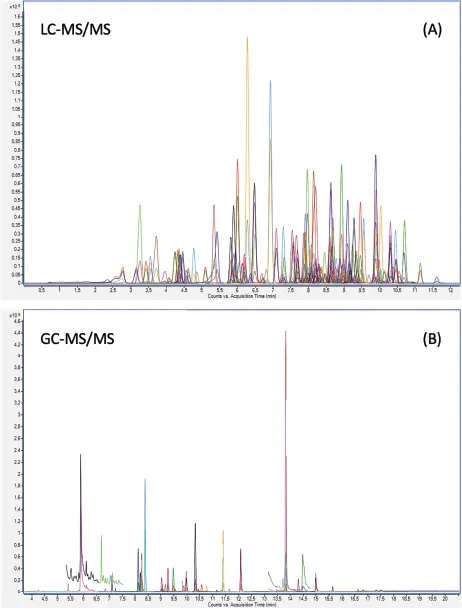
Figure 1.5 Chromatograms of the targeted pesticides by LC-MS/MS (A) and GC–MS/MS (B) of a blank soil sample spiked at 20 ng g −1. Source [99]. Reproduced with permission of Elsevier B.V.
1.3.1 Development of the Instrumental Method
1.3.1.1 Chromatography
GC enables the detection of a high number of volatile or semivolatile and thermally stable pesticides, allowing the determination of persistent pesticides in environmental matrices such as water, soil, biota and air ( Tables 1.1– 1.4). Several multiresidue methods have been developed and, for instance, 11 OCPs were determined in soils using GC with a DB-5-MS capillary column with 5% phenyl stationary phase and 95% of methylpolysiloxane [106]. Although this is the stationary phase most commonly used, other stationary phases, such as DB-XLB and DB-35-MS, were also tested for the determination of endosulfan, chlorpyrifos and their metabolites [29], obtaining the best results with DB-XLB (larger differences in the retention time of the compounds). ZB-5MSi was also tested to determine pyrethroid pesticide metabolites in soil samples [64] and a HP-5-MS UI column to analyze 58 pesticides in soil samples [61]. Additionally, pesticides can simultaneously be analyzed with other pollutants such as polycyclic aromatic hydrocarbons (PAHs), brominated diphenyl ethers (BDEs) and polychlorinated biphenyls (PCBs) in environmental matrices, such as surface waters [84], accomplishing this with the Environmental Quality Standards (EQS) fixed by Directive 2013/39/EC [10].
For non-GC amenable compounds, although chemical derivatization can be carried out, LC is recommended and liquid chromatography (LC) and, increasingly, ultra-high-performance liquid chromatography (UHPLC) are commonly used for the analysis of pesticides, using different particle sizes as 5 µm [107], 3 µm [62] or even lower (1.8 µm) [28]. For LC-amenable pesticides, conventional C18 columns are commonly used [57], with generic mobile phases such as methanol and water 0.1% formic acid 4 mm ammonium formate, allowing, for instance, the determination of parent pesticides (famoxadone) and metabolites [28]. Moreover, hydrophilic interaction liquid chromatography (HILIC) has been proposed as a promising tool for highly polar pesticides in fresh water [72] whereas a mixed-mode stationary phase is an interesting alternative [108], allowing the separation of a wide range of compounds such as polar, medium and non-polar ones. Thus, a mixed column such as XDB-C18 was used to determine 30 pesticides (herbicides, fungicides and insecticides), using as mobile phase acetonitrile and water 0.1% formic acid [93], or an EC-C18 column, using mobile phases that consisted of methanol 0.1% formic acid and 2 mm ammonium acetate, and water 0.1% formic acid and 2 mm ammonium acetate, allowing the determination of 218 pesticides [99].
Читать дальше
